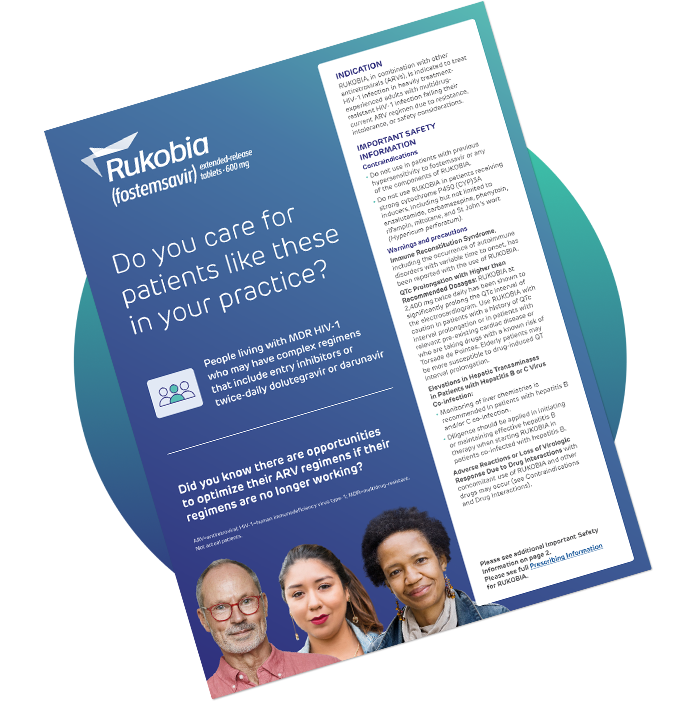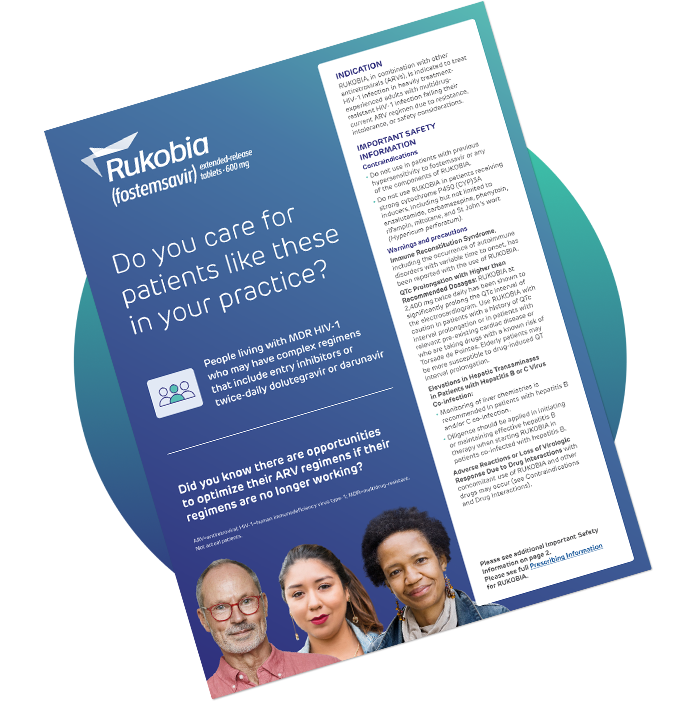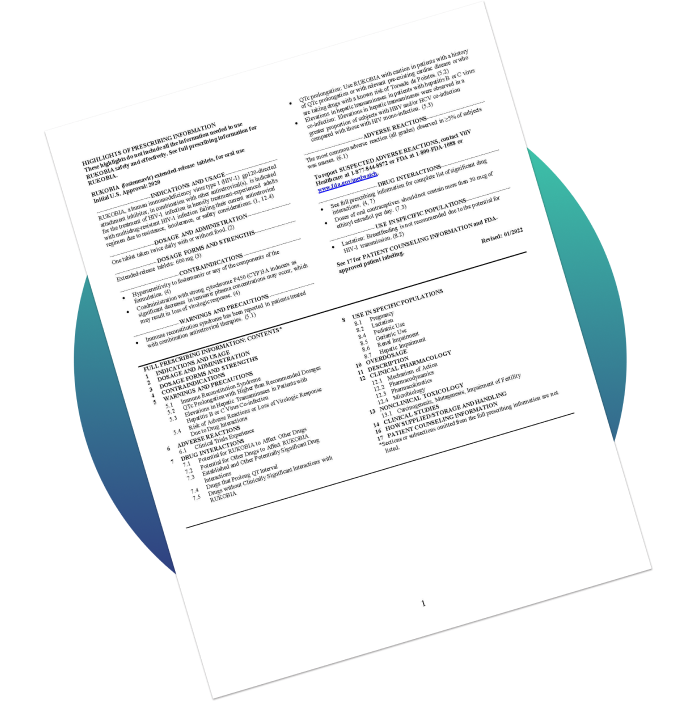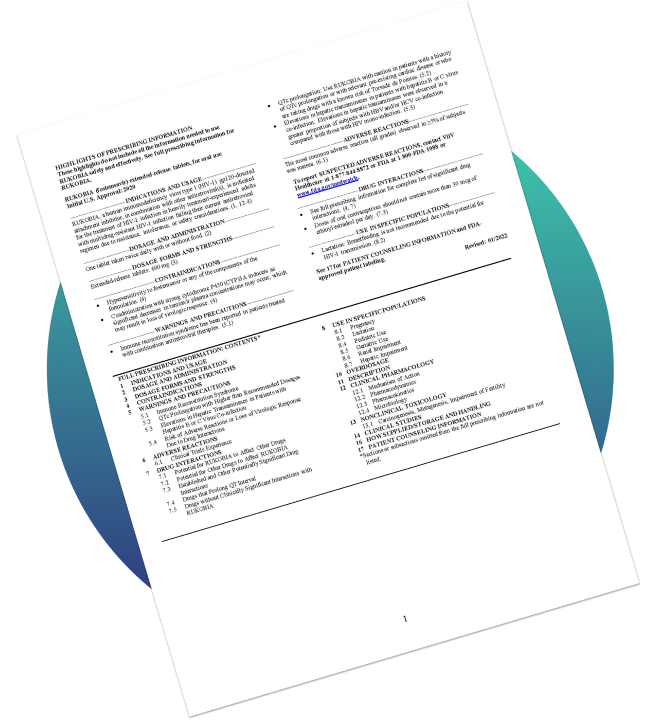VISUAL: The opening screen fades in followed by a subtle movement to the top graphic (a few lines move slowly and the brightness of a few dots gently pulsates). One second later, the RUKOBIA logo fades in at the middle of the screen along with the ViiV logo. The top graphic continues to animate subtly. The RUKOBIA logo zooms out to the left as our 240-Week BRIGHTE Trial line crosses the screen from left to right.
MUSIC: Clinical-sounding ambient music plays in the background.
Key External Expert (KEE) VO: Indication. RUKOBIA, used with other antiretrovirals, is indicated for heavily treatment-experienced adults with multidrug-resistant HIV-1 who are failing their current ARV regimen. Important Safety Information. Contraindications. Do not use in patients with previous hypersensitivity to fostemsavir or any of the components of RUKOBIA. Do not use RUKOBIA in patients receiving strong cytochrome P450 (CYP)3A inducers, including those listed here. Please see additional Important Safety Information for RUKOBIA at the end of the video. Please click the link on this page to view the full Prescribing Information for RUKOBIA.
VISUAL: INDICATION and ISI fade on screen.
KEE VO: Hello, I’m doctor Tony Mills and I’m the founder and CEO of Men’s Health Foundation.
VISUAL: 240-Week BRIGHTE Trial graphic fades to video of KEE. Nameplate to accompany KEE with credentials. The graphic zooms out to top left position of the frame and our KEE fades in. The KEE’s name bumper starts to slide in frame from right to left.
KEE VO: I am excited to share the 5-year data from the RUKOBIA BRIGHTE trial for people living with multidrug-resistant HIV-1. RUKOBIA, as part of an optimized antiretroviral regimen, is the only antiretroviral therapy specifically developed for people living with multidrug-resistant HIV-1 clinically proven to offer virologic suppression and CD4 T-cell recovery over a 5-year trial. This long-term efficacy data reinforces the durability of RUKOBIA in many people living with multidrug-resistant HIV-1.
VISUAL: KEE speaking. Nameplate to accompany KEE with credentials.
KEE VO: As we know, people living with multidrug-resistant HIV-1 have a number of concerns and goals. These include lowering the viral load to stay undetectable, increasing CD4+ T-cell count for short- and long-term health, and finding a treatment with a manageable tolerability profile.
VISUAL: “Lower Viral Load,” “Increase CD4+ T-cell Count,” “Address Tolerability Concerns” populate as they are read.
KEE VO: In a moment, we’ll review the long-term data from the BRIGHTE trial. First, let’s take a look at the trial design.
VISUAL: Section opening for trial design. Title slide fades in. The top graphic continues to animate subtly. Copy on screen fades in with a one-second delay.
KEE VO: BRIGHTE was a Phase 3, international, partially randomized trial designed to evaluate the efficacy and safety of RUKOBIA. The trial included 371 participants representing a broad range of people living with multidrug-resistant HIV-1. All participants were on failing antiretroviral regimens and had multidrug resistance. In the randomized cohort, there were 272 participants who had 1 to 2 antiretroviral classes remaining at baseline. Through Day 8, this cohort was double blind and placebo controlled. Beyond Day 8, all randomized participants received open-label RUKOBIA in addition to an individualized optimized background therapy. Additionally, there were 99 participants in the nonrandomized cohort at baseline who had 0 fully active antiretroviral agents remaining and were allowed to co-enroll into other investigational antiretroviral trials. Participants in the BRIGHTE trial were studied over 5 years.
VISUAL: Graphic builds out three boxes.
KEE VO: The primary endpoint of the BRIGHTE trial was the adjusted mean plasma HIV-1 RNA log change from Day 1 to Day 8. RUKOBIA met the primary endpoint with superior viral load reductions versus placebo.
VISUAL: Primary endpoint description appears.
KEE VO: Now let’s take a look at the long-term data for RUKOBIA derived from the 272 participants in the randomized cohort.
VISUAL: Title slide fades in. The top graphic continues to animate subtly. Copy on screen fades in with a one-second delay.
KEE VO: RUKOBIA demonstrated durable virologic suppression over 5 years. 45% of participants receiving RUKOBIA, who were previously unable to construct a successful regimen, remained virologically suppressed over 5 years in the Snapshot Analysis. The Snapshot Analysis included the entire intent-to-treat–exposed population, which received at least 1 dose of treatment. Any missing data or change in optimized background therapy was counted as virologic failure.
VISUAL: Snapshot Analysis data builds.
KEE VO: At Week 240, it’s important to note that 19 participants, which is 7% of the Snapshot Analysis, were unable to have their HIV-1 RNA values assessed due to the impact of COVID-19 and therefore counted as virologic failures.
VISUAL: Ongoing COVID impact area is shown in shaded area on graph.
KEE VO: Durable virologic suppression was also seen in the Observed Analysis, where 82% of participants taking RUKOBIA remained virologically suppressed over 5 years. The Observed Analysis includes only participants for whom HIV-1 RNA values were measured at each study visit.
VISUAL: Observed Analysis data builds.
KEE VO: RUKOBIA also demonstrated robust and sustained CD4+ T-cell recovery across all baseline CD4+ T-cell subgroups over the 5 years. Mean CD4+ T-cell counts improved from baseline over time, and increased by 296 cells per cubic millimeter at Week 240. Interestingly, the subgroup with the lowest baseline count experienced the greatest mean CD4+ T-cell increase.
VISUAL: CD4+ T-cell recovery graph slowly builds.
KEE VO: Now let’s take a look at a summary of the safety data from the BRIGHTE trial, which includes both the randomized and nonrandomized cohorts.
VISUAL: Title slide fades in. The top graphic continues to animate subtly. Copy on screen fades in with a one-second delay.
KEE VO: Over 5 years, 8 percent or 30 participants discontinued due to an adverse event. Of these, 3 percent or 12 participants discontinued due to infections, the most common adverse event leading to discontinuation.
VISUAL: Safety table builds.
KEE VO: The most frequent Grade 2-4 drug-related adverse events occurring in at least 2% of participants were nausea, diarrhea, headache, and immune reconstitution inflammatory syndrome.
VISUAL: Copy appears onscreen.
KEE VO: Thank you for your interest in the long-term data for RUKOBIA. As we know, people living with MDR HIV-1 often have complex needs. In this video, we’ve seen that over 5 years RUKOBIA demonstrated durable virologic suppression...
VISUAL: “THROUGH ~5 YEARS* DURABLE VIROLOGIC SUPPRESSION” appears next to the KEE.
KEE VO: ...and robust CD4+ T-cell recovery, helping you to confidently prescribe for this population.
VISUAL: “THROUGH ~5 YEARS* ROBUST CD4+ T-CELL RECOVERY” appears next to the KEE.
KEE VO: What can this long-term data for RUKOBIA mean for people living with multidrug-resistant HIV-1? As we know, this population requires an individualized approach to treatment. Now, with data over 5 years, creating a new regimen with RUKOBIA as the foundation may offer the stability that they need.
VISUAL: Shot of KEE with RUKOBIA logo and 240-Week BRIGHTE Trial line.
KEE VO: Important Safety Information, continued. Warnings and Precautions. Immune Reconstitution Syndrome and autoimmune disorders have been reported with the use of RUKOBIA. QTc prolongation has occurred with higher than recommended dosages of RUKOBIA. Use RUKOBIA with caution in patients with a history of QTc interval prolongation or cardiac disease, or who are taking drugs with a known risk of Torsade de Pointes. Elderly patients may be more susceptible. Monitoring of liver chemistries is recommended in patients with hepatitis B and/or C co-infection. Diligence should be applied when starting RUKOBIA in patients receiving hepatitis B therapy. Adverse reactions or loss of virologic response due to drug interactions may occur when using RUKOBIA with other drugs. Adverse Reactions. The most common adverse reaction reported with RUKOBIA was nausea.
Drug Interactions. See the full Prescribing Information for RUKOBIA for all significant drug interactions. Temsavir may increase plasma concentrations of grazoprevir and voxilaprevir. Use an alternative hepatitis C virus regimen, if possible. Use the lowest possible starting dose for statins with careful monitoring. Patients receiving RUKOBIA should not take estrogen-based therapies that contain more than 30 micrograms per day of ethinyl estradiol. Use RUKOBIA with caution in patients with additional risk factors for thromboembolic events. Use in Specific Populations. There are insufficient data on the use of RUKOBIA during pregnancy to assess drug-associated risks. Breastfeeding is not recommended in patients with HIV-1. Please click the link on this page to view the full Prescribing Information for RUKOBIA.
VISUAL: Important Safety Information fades in and begins scrolling, pace keeping in time with VO.
KEE VO: N/A
SUPERS:
References
- Aberg J, Shepherd B, Wang M, et al. Efficacy and safety of fostemsavir plus optimized background therapy in heavily treatment-experienced adults with HIV-1: Week 240 results of the Phase 3 BRIGHTE study. Poster presented at: 24th International AIDS Conference; July 29-August 2, 2022; Montreal, Canada.
- Data on file, ViiV Healthcare.
- Ackerman P, Thompson M, Molina JM, et al. Long-term efficacy and safety of fostemsavir among subgroups of heavily treatment-experienced adults with HIV-1. AIDS. 2021;35(7):1061-1072.
- Kozal M, Aberg J, Pialoux G, et al. Fostemsavir in adults with multidrug-resistant HIV-1 infection. N Engl J Med. 2020;382(13):1232-1243.
- Lataillade M, Lalezari JP, Kozal M, et al. Safety and efficacy of the HIV-1 attachment inhibitor prodrug fostemsavir in heavily treatment-experienced individuals: week 96 results of the phase 3 BRIGHTE study. Lancet HIV. 2020;7(11):740-751.
VISUAL: References appear.
MUSIC: Clinical-sounding ambient music plays in the background.
KEE VO: N/A
SUPERS: Trademarks are owned by or licensed to the ViiV Healthcare group of companies. ©2023 ViiV Healthcare or licensor. FSTVID230001 March 2023 Produced in USA.
VISUAL: Brand colors fade in. Call-to-action, logo, and sign-off appear with a one-second delay.
MUSIC: Clinical-sounding ambient music plays in the background and then stops.
BRIGHTE Long-Term Data for RUKOBIA
~5-Year efficacy results1*
Hear from Dr. Tony Mills on the exciting long-term data for RUKOBIA
*Based on BRIGHTE 240-week data.
VO: RUKOBIA Educational Series
Visual: RUKOBIA EDUCATIONAL SERIES and logos appear on screen.
VO: Heavily treatment-experienced patients.
Visual: HEAVILY TREATMENT-EXPERIENCED PATIENTS appears on the screen and then fades out
VO: Indication. RUKOBIA, used with other HIV-1 medicines, is indicated for heavily treatment-experienced adults with multidrug-resistant HIV-1 who are failing their current ARV regimen. Important Safety Information. Contraindications. Do not use in patients with previous hypersensitivity to fostemsavir or any of the components of RUKOBIA. Do not use RUKOBIA in patients receiving strong cytochrome P450 (CYP)3A inducers, including those listed here. Please see additional Important Safety Information for RUKOBIA at the end of the video. Please click the link on this page to view the full Prescribing Information for RUKOBIA.
Visual: The RUKOBIA indication, contraindications, redirect to the additional Important Safety Information at the end of the video, and link to the full Prescribing Information. The length of time supers appear on screen aligns with VO narration.
VO: Treatment advances have largely trans-formed HIV-1
Visual: A light bulb, arrow, and TREATMENT ADVANCES are drawn.
VO: into a chronic, manageable condition, with life expectancies approaching that for people without HIV-1.
Visual: HIV-1 TODAY and the pill box icon are added. MANAGEABLE CONDITION FOR MANY PATIENTS is written at the end of the arrow.
VO: Yet, for the subpopulation of HIV-1 patients who are heavily treatment-experienced, or HTE, the outlook is often much different.
Visual: An icon of 3 people is drawn, and HEAVILY TREATMENT-EXPERIENCED is written.
VO: Some patients in this group are running out of treatment options due to
Visual: A down arrow and TREATMENT OP-TIONS are added to the frame.
VO: drug resistance, safety and tolerability issues, drug interactions, and comorbidities.
Visual: The factors that limit treatment options are added to the frame.
VO: As a result of their failing regimens, Visual: The FAILING REGIMENS icon is drawn.
VO: these patients may be struggling to maintain virologic suppression, are at increased risk of transmission, may become immunocompromised and at risk of opportunistic infections, and are at higher risk of HIV-1 disease progression and death.
Visual: The risks of failing regimens are added to the frame.
VO: How HIV-1 patients become HTE is varied and complex.
Visual: HOW PATIENTS BECOME HTE is written, and multiple intersecting arrows are drawn.
VO: The accumulation of resistance mutations may prevent the consideration of newer agents within a given therapeutic class.
Visual: RESISTANCE MUTATIONS is written, followed by a shield icon. An arrow pointing down is drawn, and MAY PREVENT USE OF is written at its end. NEWER AGENTS is written and crossed out.
VO: Some HTE patients have accumulated resistance mutations due to extensive exposure to early ARVs that are now known to be suboptimal.
Visual: EXTENSIVE SUBOPTIMAL ARV EXPOSURE is written, and a clipboard icon is drawn.
VO: Additionally, resistance may have developed in HTE patients who struggled with adherence due to interruptions in care.
Visual: A weekly pill box is drawn and crossed out.
VO: Whatever combination of factors has left them with limited ARV options, some HTE patients living with HIV-1
Visual: A down arrow is drawn, and LIMITED ARV OPTIONS is written next to it. The HTE icon and label are added to the frame.
VO: are in need of ARV classes
Visual: IN NEED OF is written, and an arrow is drawn pointing to the right.
VO: with novel mechanisms of action that have favorable resistance profiles.
Visual: A microscope icon is drawn, and ARV CLASSES WITH NOVEL MOAs is written.
VO: Important Safety Information, continued. Warnings and Precautions. Immune Reconstitution Syndrome and autoimmune disorders have been reported with the use of RUKOBIA. QTc prolongation has occurred with higher than recommended dosages of RUKOBIA. Use RUKOBIA with caution in patients with a history of QTc interval prolongation or cardiac disease, or who are taking drugs with a known risk of Torsade de Pointes. Elderly patients may be more susceptible. Monitoring of liver chemistries is recommended in patients with hepatitis B and/or C co-infection. Diligence should be applied when starting RUKOBIA in patients receiving hepatitis B therapy. Adverse reactions or loss of virologic response due to drug interactions may occur when using RUKOBIA with other drugs. Adverse Reactions. The most common adverse reaction reported with RUKOBIA was nausea.
Visual: Important Safety Information scrolls on screen.
VO: Drug interactions. See the full Prescribing Information for RUKOBIA for all significant drug interactions. Temsavir may increase plasma concentrations of grazoprevir and voxilaprevir. Use an alternative hepatitis C virus regimen, if possible. Use the lowest possible starting dose for statins with careful monitoring. Patients receiving RUKOBIA should not take estrogen-based therapies that contain more than 30 micrograms per day of ethinyl estradiol. Use RUKOBIA with caution in patients with additional risk factors for thromboembolic events. Use in Specific Populations. There are insufficient data on the use of RUKOBIA during pregnancy to assess drug-associated risks. Potential risks of breastfeeding include HIV 1 transmission, developing viral resistance in HIV-positive infants, and adverse reactions in the infant. Please click on the link on this page to view the full Prescribing Information for RUKOBIA.
Visual: Important Safety Information scrolls on screen.
REFERENCES:
- Panel on Antiretroviral Guidelines for Adults and Adolescents. Guidelines for the use of antiretroviral agents in adults and adolescents with HIV. Department of Health and Human Services. https://aidsinfo.nih.gov/contentfiles/lvguidelines/adultandadolescentgl.pdf. Updated December 18, 2019. Accessed May 7, 2020.
- Thompson M, Lalezari JP, Kaplan R, et al. Safety and efficacy of the HIV-1 attachment inhibitor prodrug fostemsavir in antiretroviral-experienced subjects: week 48 analysis of AI438011, a Phase IIb, randomized controlled trial. Antivir Ther.2017;22(3):215-223.
- U.S. Department of Health and Human Services. Guidelines for the prevention and treatment of opportunistic infections in adults and adolescents with HIV: Recommendations from the Centers for Disease Control and Prevention, the National Institutes of Health, and the HIV Medicine Association of the Infectious Diseases Society of America. https://aidsinfo.nih.gov/contentfiles/lvguidelines/adult_oi.pdf. Updated November 21, 2019. Accessed May 9, 2020.
- HIV Treatment and care. Centers for Disease Control and Prevention website. https://cdc.gov/hiv/clinicians/treatment/treatment-clinicians.html. Accessed May 9, 2020.
- Data on file, ViiV Healthcare.
Visual: RUKOBIA and ViiV logos appear on screen. Trademarks are owned by the ViiV Healthcare group of companies. ©2024 ViiV Healthcare or licensor. PMUS-FSTVID240006 June 2024 Produced in USA.
Introduction to people living with MDR HIV-1
Consider challenges faced by people living with MDR HIV-1 and limited antiretroviral (ARV) options
VO: RUKOBIA Educational Series
Visual: RUKOBIA EDUCATIONAL SERIES and logos appear on screen.
VO: Mechanism of action.
Visual: MECHANISM OF ACTION appears on the screen.
VO: Indication. RUKOBIA, used with other HIV-1 medicines, is indicated for heavily treatment-experienced adults with multidrug-resistant HIV-1 who are failing their current ARV regimen. Important Safety Information. Contraindications. Do not use in patients with previous hypersensitivity to fostemsavir or any of the components of RUKOBIA. Do not use RUKOBIA in patients receiving strong cytochrome P450 (CYP)3A inducers, including those listed here. Please see additional Important Safety Information for RUKOBIA at the end of the video. Please click the link on this page to view the full Prescribing Information for RUKOBIA.
Visual: The RUKOBIA indication, contraindications, redirect to the additional Important Safety Information at the end of the vid
VO: First-in-class RUKOBIA
Visual: FIRST-IN-CLASS RUKOBIA is written on screen.
VO: is the first FDA-approved HIV-1 attachment inhibitor.
Visual: FIRST FDA-APPROVED HIV-1 ATTACHMENT INHIBITOR is written.
VO: Unlike previously approved classes that act by blocking entry following attachment of the glycoprotein 120, or gp120, viral envelope protein,
Visual: ARV CLASSES THAT BLOCK ENTRY, HIV-1, and CD4+ T-CELL are drawn.
VO: RUKOBIA acts on the HIV-1 virion before attachment of gp120 to prevent the earliest stage of HIV-1 and CD4+ T-cell engagement.
Visual: RUKOBIA, HIV-1, and CD4+ T-CELL are added to complete the frame.
VO: Temsavir, the active moiety of RUKOBIA, attaches to gp120 on the surface of HIV-1 virions, near the CD4 attachment site.
Visual: HIV-1, GP120, and TEMSAVIR are drawn.
VO: The attachment of temsavir locks gp120 into a closed formation that prevents the initial interaction between the virus and host immune cells, leaving CD4+ T-cells untouched.
Visual: PREVENTS INITIAL INTERACTION arm and CD4+ T-CELL membrane are drawn on screen.
VO: With the HIV-1 virions unable to attach to CD4+ T-cells, they are a target for elimination by the body’s immune response.
Visual: The HIV-1 virions and CD4+ T-cell are drawn. The arrow and IMMUNE RESPONSE are added to the frame.
VO: Important Safety Information, continued. Warnings and Precautions. Immune Reconstitution Syndrome and autoimmune disorders have been reported with the use of RUKOBIA. QTc prolongation has occurred with higher than recommended dosages of RUKOBIA. Use RUKOBIA with caution in patients with a history of QTc interval prolongation or cardiac disease, or who are taking drugs with a known risk of Torsade de Pointes. Elderly patients may be more susceptible. Monitoring of liver chemistries is recommended in patients with hepatitis B and/or C co-infection. Diligence should be applied when starting RUKOBIA in patients receiving hepatitis B therapy. Adverse reactions or loss of virologic response due to drug interactions may occur when using RUKOBIA with other drugs. Adverse Reactions. The most common adverse reaction reported with RUKOBIA was nausea.
Visual: Important Safety Information scrolls on screen.
VO: Drug Interactions. See the full Prescribing Information for RUKOBIA for all significant drug interactions. Temsavir may increase plasma concentrations of grazoprevir and voxilaprevir. Use an alternative hepatitis C virus regimen, if possible. Use the lowest possible starting dose for statins with careful monitoring. Patients receiving RUKOBIA should not take estrogen-based therapies that contain more than 30 micrograms per day of ethinyl estradiol. Use RUKOBIA with caution in patients with additional risk factors for thromboembolic events. Use in Specific Populations. There are insufficient data on the use of RUKOBIA during pregnancy to assess drug-associated risks. Potential risks of breastfeeding include HIV 1 transmission, developing viral resistance in HIV-positive infants, and adverse reactions in the infant. Please click on the link on this page to view the full Prescribing Information for RUKOBIA.
Visual: Important Safety Information scrolls on screen.
REFERENCES:
- Thompson M, Lalezari JP, Kaplan R, et al. Safety and efficacy of the HIV-1 attachment inhibitor prodrug fostemsavir in antiretroviral-experienced subjects: week 48 analysis of AI438011, a Phase IIb, randomized controlled trial. Antivir Ther. 2017;22(3):215-223.
- FDA Approval of HIV Medicines. AIDSinfo website. https://aidsinfo.nih.gov/understanding-hiv-aids/infographics/25/fda-approval-of-hiv-medicines. Updated April 30, 2019. Accessed May 9, 2020.
- Panel on Antiretroviral Guidelines for Adults and Adolescents. Guidelines for the use of antiretroviral agents in adults and adolescents with HIV. Department of Health and Human Services. https://aidsinfo.nih.gov/contentfiles/lvguidelines/adultandadolescentgl.pdf. Updated December 18, 2019. Accessed May 7, 2020.
- Cahn P, Fink V, Patterson P. Fostemsavir: a new CD4 attachment inhibitor. Curr Opin HIV AIDS. 2018;13(4):341-345.
Visual: RUKOBIA and ViiV logos appear on screen. Trademarks are owned by the ViiV Healthcare group of companies. ©2024 ViiV Healthcare or licensor. PMUS-FSTVID240007 June 2024 Produced in USA.
Novel mechanism of action
Discover the first-in-class attachment inhibitor that prevents HIV-1 from interacting with host immune cells
VO: RUKOBIA Educational Series
Visual: RUKOBIA EDUCATIONAL SERIES and logos appear on screen.
VO: Dosing and drug interactions.
Visual: DOSING AND DRUG INTERACTIONS appears on the screen and then fades out.
VO: Indication. RUKOBIA, used with other HIV-1 medicines, is indicated for heavily treatment-experienced adults with multidrug-resistant HIV-1 who are failing their current ARV regimen. Important Safety Information. Contraindications. Do not use in patients with previous hypersensitivity to fostemsavir or any of the components of RUKOBIA. Do not use RUKOBIA in patients receiving strong cytochrome P450 (CYP)3A inducers, including those listed here. Please see additional Important Safety Information for RUKOBIA at the end of the video. Please click the link on this page to view the full Prescribing Information for RUKOBIA.
Visual: RUKOBIA indication, contraindications, redirect to the additional Important Safety Information at the end of the video, and link to the full Prescribing Information.
VO: The recommended dose of RUKOBIA is one 600-mg tablet, taken orally, twice daily. RUKOBIA can be taken with or without food.
Visual: RUKOBIA and its dosing information are written.
VO: Tablets should be taken whole
Visual: A tablet is drawn. WHOLE is written inside of it. (NOT ACTUAL SIZE) is added to the frame.
VO: and should not be chewed, crushed, or split.
Visual: NOT is written, followed by the actions that should not be taken with a RUKOBIA tablet.
VO: For patients with renal or hepatic impairment, no dose adjustments are required.
Visual: RENAL OR HEPATIC IMPAIRMENT is written, followed by an arrow pointing to NO DOSE ADJUSTMENTS REQUIRED.
VO: The primary metabolic pathway of RUKOBIA is
Visual: PRIMARY METABOLIC PATHWAY is written, followed by RUKOBIA.
VO: through esterase hydrolysis and secondarily by pathways dependent on cytochrome P450 3A4, or CYP3A4.
Visual: A molecular structure is drawn and ESTERASE HYDROLYSIS is written.
VO: RUKOBIA may be coadministered with
Visual: RUKOBIA MAY BE COADMINISTERED WITH is written on screen.
VO: other HIV-1 ARVs, as well as with strong inhibitors of cytochrome P450, family 3, subfamily A, or CYP3A; breast cancer resistance protein, or BCRP; and/or P-glycoprotein, or P-gp,
Visual: Bulleted copy is written.
VO: without dose adjustments.
Visual: An arrow pointing right is drawn and WITHOUT DOSE ADJUSTMENTS is written.
VO: Prescribers should be aware of the contraindications with RUKOBIA.
Visual: RUKOBIA CONTRAINDICATIONS is written.
VO: RUKOBIA is contraindicated in patients who are taking strong CYP3A4 inducers, including but not limited to enzalutamide, carbamazepine, phenytoin, rifampin, mitotane, and St. John’s wort. This is due to the potential for decreased temsavir plasma concentrations, which may result in loss of virologic response.
Visual: STRONG CYP3A4 INDUCERS is written, followed by the list of drugs. POTENTIAL LOSS OF VIROLOGIC RESPONSE is added on the right.
VO: Use an alternative HCV regimen, if possible, when coadministering RUKOBIA with grazoprevir or voxilaprevir due to the potential for increased exposures of grazoprevir or voxilaprevir. Increased exposures of grazoprevir may increase the risk of ALT elevations.
Visual: USE ALTERNATIVE HCV REGIMEN, IF POSSIBLE is written, followed by remaining copy on the left side of the screen. The vial icon is drawn, followed by MAY INCREASE RISK OF ELEVATED ALT.
VO: Dose adjustment is also required for coadministration with oral contraceptive ethinyl estradiol. The daily dose of ethinyl estradiol should not exceed 30 micrograms.
Visual: COADMINISTERING RUKOBIA WITH ETHINYL ESTRADIOL is written on screen, followed by DAILY DOSE OF ETHINYL ESTRADIOL ≤30 mcg.
VO: There are considerations for coadministering RUKOBIA with statins.
Visual: COADMINISTERING RUKOBIA WITH STATINS is written.
VO: Use the lowest possible starting dose of
Visual: LOWEST POSSIBLE STARTING DOSE OF: is written
VO: rosuvastatin, atorvastatin, fluvastatin, pitavastatin, and simvastatin.
Visual: ROSUVASTATIN, ATORVASTATIN, FLUVASTATIN, PITAVASTATIN, and SIMVASTATIN are written.
VO: Careful monitoring for statin-related events is recommended.
Visual: CAREFUL MONITORING RECOMMEND-ED and a magnifying glass icon are added to the frame.
VO: Important Safety Information, continued. Warnings and Precautions. Immune Reconstitution Syndrome and autoimmune disorders have been reported with the use
of RUKOBIA. QTc prolongation has occurred with higher than recommended dosages of RUKOBIA. Use RUKOBIA with caution in patients with a history of QTc interval prolongation or cardiac disease, or who are taking drugs with a known risk of Torsade de Pointes. Elderly patients may be more susceptible. Monitoring of liver chemistries is recommended in patients with hepatitis B and/or C co-infection. Diligence should be applied when starting RUKOBIA in patients receiving hepatitis B therapy. Adverse reactions or loss of virologic response due to drug interactions may occur when using RUKOBIA with other drugs. Adverse Reactions. The most common adverse reaction reported with RUKOBIA was nausea.
Visual: Important Safety Information scrolls on screen.
VO: Drug Interactions. See the full Prescribing Information for RUKOBIA for all significant drug interactions. Temsavir may increase plasma concentrations of grazoprevir and voxilaprevir. Use an alternative hepatitis C virus regimen, if possible. Use the lowest possible starting dose for statins with careful monitoring. Patients receiving RUKOBIA should not take estrogen-based therapies that contain more than 30 micrograms per day of ethinyl estradiol. Use RUKOBIA with caution in patients with additional risk factors for thromboembolic events. Use in Specific Populations. There are insufficient data on the use of RUKOBIA during pregnancy to assess drug-associated risks. Potential risks of breastfeeding include HIV 1 transmission, developing viral resistance in HIV-positive infants, and adverse reactions in the infant. Please click on the link on this page to view the full Prescribing Information for RUKOBIA.
Visual: Important Safety Information scrolls on screen.
Visual: RUKOBIA and ViiV logos appear on screen. Trademarks are owned by the ViiV Healthcare group of companies. ©2024 ViiV Healthcare or licensor. PMUS-FSTVID240008 June 2024 Produced in USA.
Dosing and drug interactions
Review recommended dosing, considerations for coadministration, and contraindications with RUKOBIA





